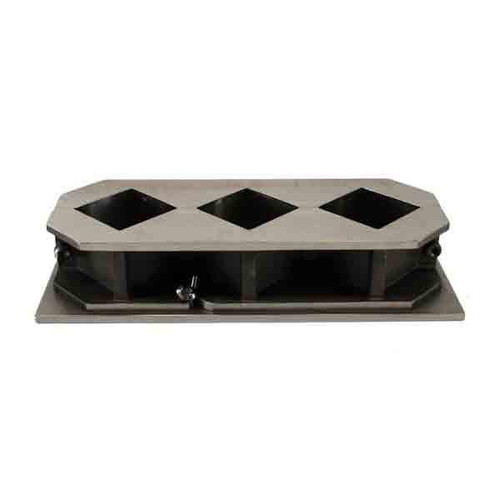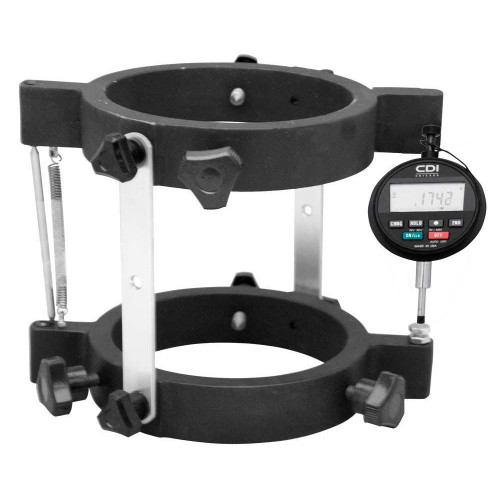Concrete Testing with Concrete Compression Equipment
Concrete testing is a big part of the construction industry, making sure concrete structures are durable, safe and of good quality. Concrete strength is tested in many ways, each giving different information. Compressive strength tests are the most important in determining the overall strength of concrete as they are more reliable and commonly used because of their sensitivity to testing conditions and loading rates. This post will cover the different methods to test compressive strength, tensile strength and overall quality of concrete. It will go into the details of each testing method, their applications and why accurate measurement is important in construction projects.
Compressive Strength Tests of Concrete
Compressive strength is one of the properties of concrete that determines its ability to withstand loads and stresses. It is the maximum stress a concrete specimen can withstand without failing. Compressive strength is measured by applying a compressive load to a cylindrical concrete specimen until it fails. Water-cement paste ratio, cement strength, quality of concrete materials and quality control during production are the factors that affect compressive strength of concrete. Understanding these factors is important to ensure that concrete structures can withstand the intended loads and stresses and be safe and durable.
Why Concrete Strength Testing is Needed
Concrete compressive strength testing is important for: Quality Control: To ensure the concrete used meets the required standards and specifications. Safety: To verify that structures can withstand the intended loads and stresses. Durability: To assess the long term performance and resilience of concrete under various conditions. Compliance: To confirm to industry standards and regulations such as ASTM and ACI.
Common Concrete Compressive Strength Testing Methods
1. Compression Testing Machine
The compression testing machine is one of the most common method of testing concrete compressive strength. This test involves crushing cylindrical concrete specimens, usually prepared as part of the quality process in both lab and field. Concrete cylinders are also used in testing concrete’s split tensile strength following ASTM C496.
Procedure:
-
Concrete Cylinders and Specimen Preparation: Cylindrical concrete specimens are prepared and cured in controlled environment.
-
Loading: The specimen is placed in the compression testing machine and a compressive load is applied gradually until failure.
-
Measurement: The maximum load is recorded and the compressive strength is calculated using the formula:
[ \text{Compressive Strength} = \frac{\text{Maximum Load}}{\pi \times (\text{Diameter}/2)^2} ]
This method gives reliable data for quality and compliance purposes.
2. Ultrasonic Pulse Velocity Method
The ultrasonic velocity method is a non-destructive testing method that measures the speed of ultrasonic pulses through the concrete. This method is used to evaluate the quality and uniformity of concrete and detect voids or cracks.
Procedure:
-
Setup: Ultrasonic transducers are placed on opposite side of the concrete.
-
Pulse Generation: Ultrasonic pulse is generated and sent through the concrete.
-
Measurement: Time taken for the pulse to travel through the concrete is measured.
This method does not damage the concrete.
3. Penetration Resistance Test
The penetration resistance test involves driving a metal rod or pin into the concrete to measure its resistance. This test gives information about the surface hardness and indirectly the strength of the concrete.
Procedure:
-
Setup: A penetration device, such as a spring-driven hammer, is used.
-
Penetration: The device drives a metal pin into the concrete.
-
Measurement: The depth of penetration is measured.
This method is quick and easy to use, good for field applications.
4. Pullout Test
The pullout test involves measuring the force required to pull a metal insert or anchor from the concrete. This test gives direct information about the tensile strength and bond strength of the concrete. Concrete flexural strength, a key property that measures the ability of unreinforced concrete slabs or beams to resist bending or failure is also evaluated through this method.
Procedure:
-
Insert Placement: A metal insert is embedded in the concrete.
-
Pulling: A pulling device is attached to the insert and force is applied until it is pulled out.
-
Measurement: The force is recorded, gives data on the concrete’s tensile strength.
This method is good for bond strength and integrity of in situ concrete element.
5. Rebound Hammer Test
The rebound hammer test is a non-destructive method that measures the surface hardness of concrete using the rebound principle.
Procedure:
-
Setup: Schmidt hammer is placed on the concrete surface.
-
Impact: The hammer’s spring-driven mass strikes the concrete surface.
-
Measurement: The rebound distance of the hammer mass is measured.
This method is used for on-site and quality.
Advanced Testing Methods for Ultra High Performance Concrete
1. Maturity Method
The maturity method involves using the temperature history of the concrete to estimate its strength. This method uses wireless maturity sensors embedded in the concrete to collect temperature data over time.
Procedure:
-
Sensor Placement: Wireless maturity sensors are placed in the concrete.
-
Data Collection: Temperature data is collected during the curing process.
-
Strength Estimation: Using the maturity equation, the strength is estimated based on the temperature history.
This method gives real-time strength data and is good for optimizing curing times and project schedules.
2. Combined Methods
Combining different methods can give a more complete picture of concrete strength. For example, using pulse velocity with compression test can enhance the accuracy of strength evaluation. Indirect methods such as flexural strength and split tensile strength test can be used to evaluate tensile strength without applying tension to the material.
Procedure:
-
Initial Testing: Perform non-destructive test, such as ultrasonic pulse velocity, to assess internal condition.
-
Supplementary Testing: Conduct compression test by extracting concrete sample or even multiple concrete samples to confirm strength data.
-
Data Analysis: Combine results from both methods to get a complete picture of concrete quality and strength.
This will give more reliable strength assessment and will help to identify potential problems early.
Factors Affecting Concrete Strength Testing Method Using Cylindrical Concrete Specimens
Several factors can affect the accuracy and reliability of concrete strength testing when you do cylinder break test: Tensile forces can cause cracks and affect the overall strength of the concrete as these forces exceed the tensile strength of the material.
1. Curing Conditions: The conditions under which the hardened concrete specimens are cured, including temperature and humidity, will affect the test result.
2. Concrete Mix: The mix composition, including the type and proportion of aggregates will affect the strength.
3. Specimen Preparation: Proper preparation and handling of test specimens is crucial to get accurate result.
4. Loading Rate: The rate of loading during compression test must be controlled to get consistent and accurate measurement.
5. Testing Location: Testing concrete in situ versus in the lab will give different result due to variation in condition and handling.
Get Accurate Measurement
To get accurate measurement, follow standardized testing method and procedure. Consider tensile stress in testing procedure is crucial to get accurate measurement. This includes:
-
Calibration: Regular calibration of testing equipment is necessary to get accuracy.
-
Procedure: Follow standardized procedure, such as ASTM and ACI, to get consistency and reliability.
-
Quality Control: Implement strict quality control and measure concrete strength throughout the process to get quality and strength of concrete.
-
Data Analysis: Analyze test data including the influencing factors to get complete picture of concrete strength when you have accurate data.
Ultra High Performance Concrete (UHPC)
Ultra High Performance Concrete (UHPC) is a type of concrete that has exceptional compressive strength, often above 29,000 psi (200 MPa). UHPC is made by combining cement, silica fume and quartz flour to get a concrete mix that is not only strong but also durable and resistant to degradation. Due to its properties, UHPC is used in high performance application such as bridges, high rise building and critical infrastructure. Its ability to withstand extreme load and harsh environment make it the best choice for demanding construction.
Concrete Mix Design and Compressive Strength
The mix design is the key to the compressive strength of the final product. Mix design is the process of selecting the right proportion of cement, aggregate, water and concrete mixture to get the desired strength and workability. One of the most important factor in this process is the water-cement ratio; lower ratio will give higher compressive strength. The type and quality of cement, aggregate and concrete mixture used in the mix also affect the compressive strength. By designing the mix properly, engineers can ensure that the concrete meets the requirement of the project.
Cylindrical Concrete Specimen Preparation
Preparing cylindrical concrete specimen is the first step to determine the compressive strength of concrete. The process starts by using a mold to shape the concrete into cylindrical form. The concrete is then compacted and finished to remove any defects that can affect the test result. After molding, the specimen is cured in controlled environment to get the desired strength. The size and shape of the specimen can affect the compressive strength result, so it’s important to follow standard testing procedure. Proper preparation and curing is necessary to get accurate and reliable compressive strength measurement.
Compressive Strength Testing Machine
Compressive strength testing machine is designed to apply compressive load to a cylindrical concrete specimen until it fails. The machine consists of loading frame, hydraulic pump and control system. The loading frame ensure uniform load to the specimen, the hydraulic pump provide the required pressure to get the desired load and the control system monitor the load and deformation of the specimen during the test and calculate the compressive strength based on the maximum load. This machine is necessary to get accurate compressive strength of concrete, for quality control and compliance purpose.
Applications and Advantages of Concrete Strength Testing
Concrete strength testing is applied in different stages of the construction process, from initial quality to ongoing monitoring of structural integrity. Concrete flexural strength is one of the property of concrete that measures the ability of unreinforced concrete slab or beam to resist bending or failure, so it’s important in concrete quality assessment. The benefits are:
-
Safer: Ensure that structure can withstand the intended load and stress, reduce the risk of failure.
-
Better Quality: Verify that concrete meet the required standard and specification, improve the overall construction quality.
-
Faster Construction Schedules: Real time strength data from method like maturity method can help to optimize curing time and project schedule.
-
Cost Effective: Early detection of potential problem can prevent costly repair and rework.
-
Compliance: Ensure compliance to industry standard and regulation, for project approval and certification.
Concrete strength testing is an essential part of construction industry, provides important data on hardened concrete performance and quality. Different testing methods like compression testing, ultrasonic pulse velocity, penetration resistance technique, pullout test and rebound hammer test gives different aspect of concrete strength. By following standard procedure and considering the influencing factor, we can get accurate and reliable strength measurement, for safety, quality and durability of concrete structure.
Use multiple testing method and maturity method to get more accuracy and coverage. As construction technology advances, concrete strength testing method must be robust and reliable to improve quality, safety and project outcome.





























































